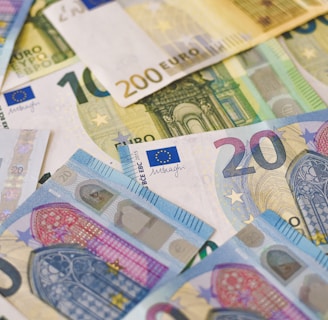What is Currency Trading?
1/1/20253 min read


Currency trading, also known as forex (foreign exchange) trading, is one of the largest and most liquid financial markets in the world. With over $6 trillion traded daily, it offers immense opportunities for traders who understand the intricacies of the market. Whether you're a seasoned stock trader or new to the world of finance, this guide will help you navigate the basics of currency trading and set you on the path to becoming a successful forex trader.
At its core, currency trading involves buying one currency while simultaneously selling another. These currencies are traded in pairs, such as EUR/USD (Euro/US Dollar) or GBP/JPY (British Pound/Japanese Yen). The value of a currency pair reflects how much of the quote currency (the second currency) is needed to buy one unit of the base currency (the first currency).
For example, if the EUR/USD pair is trading at 1.10, it means 1 Euro is equal to 1.10 US Dollars.
Why Trade Forex?
High Liquidity: The forex market operates 24 hours a day, 5 days a week, with participants ranging from individual traders to large financial institutions. This ensures high liquidity, allowing traders to enter and exit positions with ease.
Leverage: Forex brokers often provide leverage, enabling traders to control large positions with a relatively small amount of capital. While leverage amplifies profits, it also increases risks, making proper risk management essential.
Global Market Access: Forex trading allows you to participate in a truly global market, trading currencies from all over the world.
Diverse Strategies: Whether you’re a short-term day trader or a long-term investor, forex offers strategies for everyone, from scalping to swing trading and beyond.
Key Concepts in Currency Trading
1. Pips and Spreads
A pip is the smallest price movement in a currency pair. For most pairs, it’s the fourth decimal place (e.g., 0.0001). The spread is the difference between the bid (buy) and ask (sell) price of a currency pair. A tighter spread means lower trading costs.
2. Major, Minor, and Exotic Pairs
Major pairs: Include the most traded currencies like EUR/USD and USD/JPY.
Minor pairs: Do not include the US Dollar, such as EUR/GBP.
Exotic pairs: Combine a major currency with a currency from a developing market, like USD/TRY (US Dollar/Turkish Lira).
3. Technical and Fundamental Analysis
Successful forex trading often combines:
Technical analysis: Using charts and indicators like moving averages, RSI, and Fibonacci retracements to predict price movements.
Fundamental analysis: Assessing economic indicators such as interest rates, GDP growth, and geopolitical events to evaluate a currency’s strength.
4. Risk Management
Risk management is crucial in forex trading. Tools like stop-loss orders and position sizing help protect your capital. A general rule is to risk only 1-2% of your trading capital on a single trade.
Steps to Start Currency Trading
Learn the Basics: Familiarize yourself with forex terminology, market mechanics, and trading strategies.
Choose a Broker: Select a reputable forex broker with a user-friendly platform, competitive spreads, and strong customer support.
Open a Demo Account: Practice trading with virtual money to refine your strategies without risking real capital.
Develop a Trading Plan: Define your goals, risk tolerance, and preferred trading style.
Start Small: Begin trading with a small account to gain experience while minimizing risk.
Common Mistakes to Avoid
Overleveraging: Using too much leverage can quickly deplete your trading account.
Ignoring News Events: Economic announcements can cause significant volatility. Always stay informed.
Lack of Discipline: Emotional trading often leads to poor decisions. Stick to your trading plan.
Conclusion
Currency trading is an exciting and rewarding venture, but it requires education, discipline, and practice. By understanding the fundamentals and developing a solid trading plan, you can unlock the potential of the forex market. At Sharma Trading School, we provide resources, community support, and professional guidance to help you master currency trading. Ready to take the first step? Join our community today and begin your journey to becoming a skilled forex trader.
